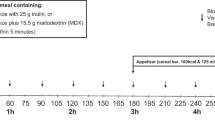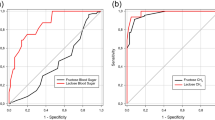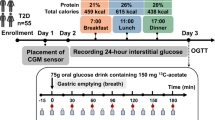Abstract
Objectives: Lactose [13C]ureide has been proposed as a noninvasive marker for oro-caecal transit time in adults and children. The present study investigates the handling of lactose [13C]ureide (13C LU) and glucose [13C]ureide (13C GU) by the gastrointestinal tract and describes the metabolic fates of these substrates and describes the extent of tracer excretion by different routes.
Study Design and Subjects: Four subjects underwent five studies in which they ingested a test meal plus (1) no substrate, (2) 13C LU, (3) 13C GU, (4) 13C LU after predosing with unlabelled lactose ureide and (5) 13C LU after predosing with glucose ureide. Subjects were studied at home with at least 1 week between tests and they all completed the study. Breath was analysed for 13CO2 recovery and urine was analysed for total 13C recovery, 13C urea recovery and 13C GU recovery.
Results: The profiles and extent of tracer recovery in breath and urine were similar when either 13C GU or 13C LU was used, suggesting similar handling of these substrates by the gut. 13C GU was the major 13C-enriched species recovered in the urine even when 13C LU was consumed. Predosing with either lactose ureide or glucose ureide increased the rate of appearance of tracer, but did not alter transit times.
Conclusions: 13C LU is hydrolysed to 13C GU in the small intestine with the fraction of 13C GU appearing in the urine probably limited by small intestinal permeability. Either 13C LU or 13C GU can be used to measure oro-caecal transit time.
Sponsorship: Bell College, Hamilton and Chief Scientist Office, Scotland, UK.
This is a preview of subscription content, access via your institution
Access options
Subscribe to this journal
Receive 12 print issues and online access
$259.00 per year
only $21.58 per issue
Buy this article
- Purchase on Springer Link
- Instant access to full article PDF
Prices may be subject to local taxes which are calculated during checkout




Similar content being viewed by others
References
Bond JH & Levitt MD (1975): Investigation of small bowel transit time in man utilising pulmonary hydrogen (H2) measurements. J. Lab. Clin. Med. 85, 546–555.
Calbet JA & Maclean DA (1997): Role of caloric content on gastric emptying in humans. J. Physiol. 498, 553–559.
Corazza G, Strocchi A, Sorge, Bentai G & Gasbarrini G (1993): Prevalence and consistency of low breath H2 excretion following lactulose ingestion. Dig. Dis. Sci. 38, 2010–2016.
Craig H (1957): Isotopic standards for carbon and oxygen and correction factors for mass spectrometric analysis of carbon dioxide. Geochim. Cosmochim. Acta 12, 133–149.
Elia M, Jones MG, Jennings G, Poppitt SD, Fuller NJ, Murgatroyd PR & Jebb SA (1995): Estimating energy expenditure from specific activity of urine urea during lengthy subcutaneous NaH14CO3 infusion. Am. J. Physiol. 269, E172–E182.
Favier C, Neut C, Mizon C, Cortot A, Colombel JF & Mizon J (1997): Fecal β-D-galactosidase production and bifidobacteria are decreased in Crohn's disease. Dig. Dis. Sci. 42, 817–822.
Geypens B, Bennink R, Peeters M, Evenepoel P, Mortelmans L, Macs B, Ghoos Y & Rutgeerts P (1999): Validation of lactose [13C]ureide breath test for determination of oro-caecal transit time by scintigraphy. J. Nucl. Med. 40, 1451–1455.
Ghoos Y, Maes B, Geypens B, Mys G, Hiele MI, Rutgeerts PJ & Vantrappen G (1993): Measurement of gastric emptying rate of solids by means of a carbon-labeled octanoic acid breath test. Gastroenterology 104, 1640–1647.
Graff J, Brinch K & Madsen J (2000): Simplified scintigraphic methods for measuring gastrointestinal transit times. Clin. Physiol. 20, 262–266.
Graham DY, Klein PD, Evans Jr DJ, Evans DG, Alpert LC & Opekun AR (1987): Campylobacter pylori detected noninvasively by the 13C-urea breath test. Lancet 1(8534), 1174–1177.
Heine WE, Berthold HK & Klein PD (1995): A novel stable isotope breath test: 13C labeled glycosyl ureides used as noninvasive markers of intestinal transit time. Am. J. Gastroenterol. 90, 93–98.
Hoerr RA, Yu Y, Wagner DA, Burke JF & Young VR (1989): Recovery of 13C in breath from NaH13CO3 infused by gut and vein: effect of feeding. Am. J. Physiol. 257, E426–E438.
Irving CS, Wong W, Shulman RJ, Smith EO & Klein PD (1983): [13C]bicarbonate kinetics in humans: intra- vs. interindividual variations. Am. J. Physiol. 245, R190–R202.
Jackson AA, Bundy R, Hounslow A, Murphy JL & Wootton SA (1999): Metabolism of lactose-[13C]ureide and lactose-[15N, 15N]ureide in normal adults consuming a diet marginally adequate in protein. Clin. Sci. 97, 547–555.
Leijssen DP & Elia M (1996): Recovery of 13CO2 and 14CO2 in human bicarbonate studies: a critical review with original data. Clin. Sci. 91, 665–677.
Menzies IS (1984): Transmucosal passage of inert molecules in health and disease. In Intestinal Absorption and Secretion E Skadhauge & K Heintze (eds), Falk Symposium 36, pp 527–543. MTP Press, Boston.
Miller MA, Parkman HP, Urbain JL, Brown KL, Donahue DJ, Knight LC, Maurer AH & Fisher RS (1997): Comparison of scintigraphy and lactulose breath hydrogen test for assessment of orocecal transit: lactulose accelerates small bowel transit. Dig. Dis. Sci. 42, 10–18.
Mohr C, Heine WE & Wutzke KD (1999): Clostridium inocuum: a glucose-ureide splitting inhabitant of the human intestinal tract. Biochim. Biophys. Acta 1472, 550–554.
Moran BJ & Jackson AA (1990): 15N-urea metabolism in the functioning human colon: luminal hydrolysis and mucosal permeability. Gut 31, 454–457.
Morrison DJ, Dodson B & Preston T (1999): Measurement of urinary total 13C and 13C urea by isotope ratio mass spectrometry after administration of lactose [13C]ureide. Rapid Commun. Mass Spectrom. 13, 1252–1256.
Morrison DJ, Dodson B, Preston T & Weaver LT (2001): Rapid quality control analysis of 13C enriched substrate synthesis by isotope ratio mass spectrometry. Rapid Commun. Mass Spectrom. 15, 1279–1282.
Morrison DJ, Dodson B, Slater C & Preston T (2000): 13C natural abundance in the British diet: implications for 13C breath tests. Rapid Commun. Mass Spectrom. 14, 1321–1324.
Morrison DJ, Zavoshy R, Edwards CA, Dodson B, Preston T & Weaver LT (1998): Lactose [13C]-ureide as a marker for colonic fermentation and the deconvolution of a complex 13CO2 breath test curve. Biochem. Soc. Trans. 26, S184.
Motulsky HJ & Ransnas LA (1987): Fitting curves to data using nonlinear regression: a practical and nonmathematical approach. FASEB J. 1, 365–374.
Preston T & McMillan DC (1988): Rapid sample throughput for biomedical stable isotope tracer studies. Biomed. Environ. Mass Spectrom. 16, 229–235.
Read NW, Cammack J, Edwards C, Holgate AM, Cann PA & Brown C (1982): Is transit time of a meal through the small intestine related to the rate at which it leaves the stomach. Gut 23, 824–828.
Reynolds JC (1996): Challenges in the treatment of colonic motility disorders. Am. J. Health Syst. Pharm. 53 Suppl 3, S17–S26.
Ruemmele FM, Heine WE, Keller KM & Lentze MJ (1997): Metabolism of glycosyl ureides by human intestinal brush border enzymes. Biochim. Biophys. Acta. 1336, 275–280.
Santangelo A, Peracchi M, Conte D, Fraquelli M & Porrini M (1998): Physical state of meal affects gastric emptying, cholecystokinin release and satiety. Br. J. Nutr. 80, 521–527.
Schoeller DA, Brown C, Nakamura A, Nakagawa A, Mazzeo RS, Brooks GA & Budinger TF (1984): Influence of metabolic fuel on the 13C/I2C ratio of breath CO2 . Biomed. Mass Spectrom. 11, 557–561.
Shreeve WW, Cerasi E & Luft R (1970): Metabolism of [2-14C]pyruvate in normal, acromegalic and HGH treated human subjects. Acta Endocrinol. 65, 155–169.
Siegel JA, Urbain JL, Adler LP, Charkes ND, Maurer AH, Krevsky B, Knight LC, Fisher RS & Malmud LS (1988): Biphasic nature of gastric emptying. Gut 29, 85–89.
Slater C, Preston T & Weaver LT (2001): Calibration of a heart rate monitor to estimate CO2 production rate for 13C-breath tests. Proc. Nutr. Soc. 60, 8A.
Van Den Driessche M, Van Malderen N, Geypens B, Ghoos Y & Veerman-Wauters G (2000): Lactose [13C]ureide breath test: a new, noninvasive technique to determine orocecal transit time in children. J. Pediatr. Gastroenterol. Nutr. 31, 433–438.
Wutzke KD, Heine WE, Plath C, Leitzmann P, Radke M, Mohr C, Richter I, Gulzow HU & Hobusch D (1997): Evaluation of oro-caecal transit time; a comparison of the lactose [13C]ureide 13CO2 and the H2 breath tests in humans. Eur. J. Clin. Nutr. 51, 11–19.
Author information
Authors and Affiliations
Contributions
Guarantor: DJ Morrison.
Contributors: DJM was involved in the design of the study, carried out all analyses involved and is the main author of the manuscript. BD was involved in the design of the study, advised on chemical synthesis and analyses and contributed to the development of the manuscript. TP was involved in the design of the study, advised on isotopic analyses and contributed to the development of the manuscript. LTW was involved in the design of the study, advised on the study protocols and contributed to the development of the manuscript.
Corresponding author
Rights and permissions
About this article
Cite this article
Morrison, D., Dodson, B., Preston, T. et al. Gastrointestinal handling of glycosyl [13C]ureides. Eur J Clin Nutr 57, 1017–1024 (2003). https://doi.org/10.1038/sj.ejcn.1601637
Published:
Issue Date:
DOI: https://doi.org/10.1038/sj.ejcn.1601637
Keywords
This article is cited by
-
Analysis of the urinary glucose-[15N, 15N]-ureide content in the study of the lactose-[15N, 15N]-ureide metabolism in healthy humans
European Journal of Clinical Nutrition (2011)
-
The metabolic fate of doubly labelled lactose-[13C, 15N]ureide after pre-dosing with different ureides
European Journal of Clinical Nutrition (2010)
-
Use of the lactose-[13C]ureide breath test for diagnosis of small bowel bacterial overgrowth: comparison to the glucose hydrogen breath test
Journal of Gastroenterology (2009)
-
The duration of enzyme induction in orocaecal transit time measurements
European Journal of Clinical Nutrition (2007)
-
Comparison of accuracy and precision of heart rate calibration methods to estimate total carbon dioxide production during 13C-breath tests
European Journal of Clinical Nutrition (2006)



